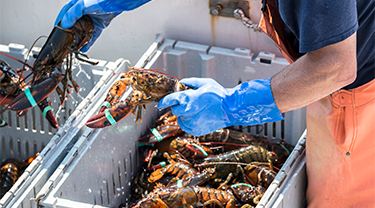Canadian fish and seafood products are renowned worldwide for their quality and taste, and are highly desired by consumers everywhere. But producers tend to sell most of their products to just two markets, with nearly 84% of Canada’s $8.1 billion-worth of fish and seafood exports going to the United States (68%) and China (16%) last year.
While the U.S. and China will always be important markets due to their sheer size, China’s 25% tariff on Canadian seafood products and ongoing trade uncertainty in the U.S. have left the industry vulnerable. This highlights the importance of trade diversification strategies for Canadian seafood exporters. With that in mind, Export Development Canada’s Economics team undertook a trade diversification analysis for the industry.
You should also check out
Canada’s new Indo-Pacific Agriculture and Agri-Food Office serves up more opportunities for exporters.
Our analysis looks at the Top 25 markets of opportunity for Canada, as identified in a 2025 EDC study. From an industry perspective, we focused on those seafood products for which Canada enjoys a revealed comparative advantage relative to its peers. Bringing these together, the objective was to highlight trade diversification opportunities by seafood product, ranking markets based on:
1. Canada’s comparative advantage relative to the target market;
2. Canada’s competitiveness in the target market; and
3. The target market’s import growth potential.
Our results identified four products that offer the greatest opportunities for trade diversification:
· Live/fresh/chilled lobster;
· Frozen lobster (lobster tail, whole cooks);
· Prepared/preserved lobster (lobster meat); and
· Frozen crab.
We narrowed our results by reviewing which markets were the largest global importers for each product, while considering these markets’ current seafood consumption and evolving preferences. We also conducted a series of qualitative interviews with industry experts, allowing us to incorporate market insights that are difficult to capture through data alone.
Across these four products, Canada exported nearly $4.4 billion in 2024, with the U.S. and China accounting for between 78% to 95% of total sales, depending on the product. However, our analysis revealed several interesting market diversification opportunities.
European and United Kingdom seafood market opportunities
Live, fresh, chilled lobster export potential in the EU: France, Italy and Spain are the largest European Union (EU) importers of live lobster, accounting for 4% of Canada’s 2024 live lobster exports. Canada and the U.S. are among these EU markets’ Top 3 import sources for the same species of lobster. Rising trade tensions between the U.S. and the EU could raise the cost of imports and decrease EU demand for U.S.-sourced live lobster. Canada is well-positioned to take some of this market share, in the context of our Comprehensive Economic and Trade Agreement (CETA).
Processed lobster market trends in the EU: Potential U.S. tariffs could lead to lower U.S. demand for Canadian live lobster and result in an oversupply. This could bring down Canadian live lobster prices and increase the share of lobster that’s processed and exported, decreasing prices throughout the lobster supply chain.
Less expensive processed lobster could increase demand from price-sensitive EU markets. For frozen lobster, Spain, France and the U.K. are highlighted as opportunity markets, as the three largest EU importers of frozen lobster, and given Canada’s competitive positioning as the leading supplier in these markets. For preserved/prepared lobster, the U.K., Italy and France are highlighted as opportunity markets given their large import demand and ranking among Canada’s Top 4 export markets (outside the U.S. and China) last year.
Growth opportunities in the Indo-Pacific seafood market
Among the Top 25 consumers of seafood in the world, consuming between 41 to 56 kilograms per person per year, Japan, South Korea and Vietnam show strong potential. This provides Canadian seafood exporters an opportunity to further grow their presence in the Indo-Pacific region.
Frozen (snow) crab export potential in Japan and South Korea: Japan is the second-largest importer of frozen crab globally, with South Korea and Vietnam also in the Top 5. Russia is Canada’s main competitor in the region, given its proximity and lower freight costs. However, potential U.S. tariffs on Canadian frozen crab could lead to weaker price dynamics, potentially raising demand from typically price-sensitive Indo-Pacific markets, especially Japan and Vietnam.
Processed lobster demand: Japan and South Korea have relatively large demand for frozen lobster and prepared/preserved lobster. Globally, both are within the Top 5 importers of frozen lobster and among the Top 10 importers of prepared/preserved lobster. Canada is the leading supplier of both frozen lobster and prepared/preserved lobster in Japan and South Korea.
Emerging seafood market opportunities in the United Arab Emirates (UAE)
Prepared/preserved lobster export growth: Globally, the UAE is the sixth-largest importer of prepared/preserved lobster. This market is increasing its imports each year, with growth of around 54% between 2018-2023. Since 2021, Canada has seen sales surge almost 70%.
The bottom line: Opportunities for Canadian seafood exports
Canadian seafood products command a certain cachet globally. As disposable incomes around the world rise and appetite for seafood increases, there are numerous opportunities for Canadian suppliers to diversify into markets beyond the U.S. and China.
While international expansion can be challenging, it can also help smooth out volatile market conditions and country-specific risks. A strategy of building strong relationships across multiple regions is an ideal way to grow the resilience of this important Canadian industry.
EDC offers a range of solutions and is here to help. EDC InList is a vetted list of air and ocean freight forwarders that helps exporters identify reliable freight options to support the shipment of perishables. Our financial products can assist with the cash flow needs of seafood exporters and mitigate the risks of doing business with new customers, in new markets. Additionally, our Business Connections program can provide seafood exporters with the resources needed to establish a global presence.
This week, a very special thanks to Marina Malcheva and Karicia Quiroz.
As always, at EDC Economics, we value your feedback. If you have ideas for topics that you’d like us to explore, please email us at economics@edc.ca and we’ll do our best to cover them.
This commentary is presented for informational purposes only. It’s not intended to be a comprehensive or detailed statement on any subject and no representations or warranties, express or implied, are made as to its accuracy, timeliness or completeness. Nothing in this commentary is intended to provide financial, legal, accounting or tax advice nor should it be relied upon. EDC nor the author is liable whatsoever for any loss or damage caused by, or resulting from, any use of or any inaccuracies, errors or omissions in the information provided.






